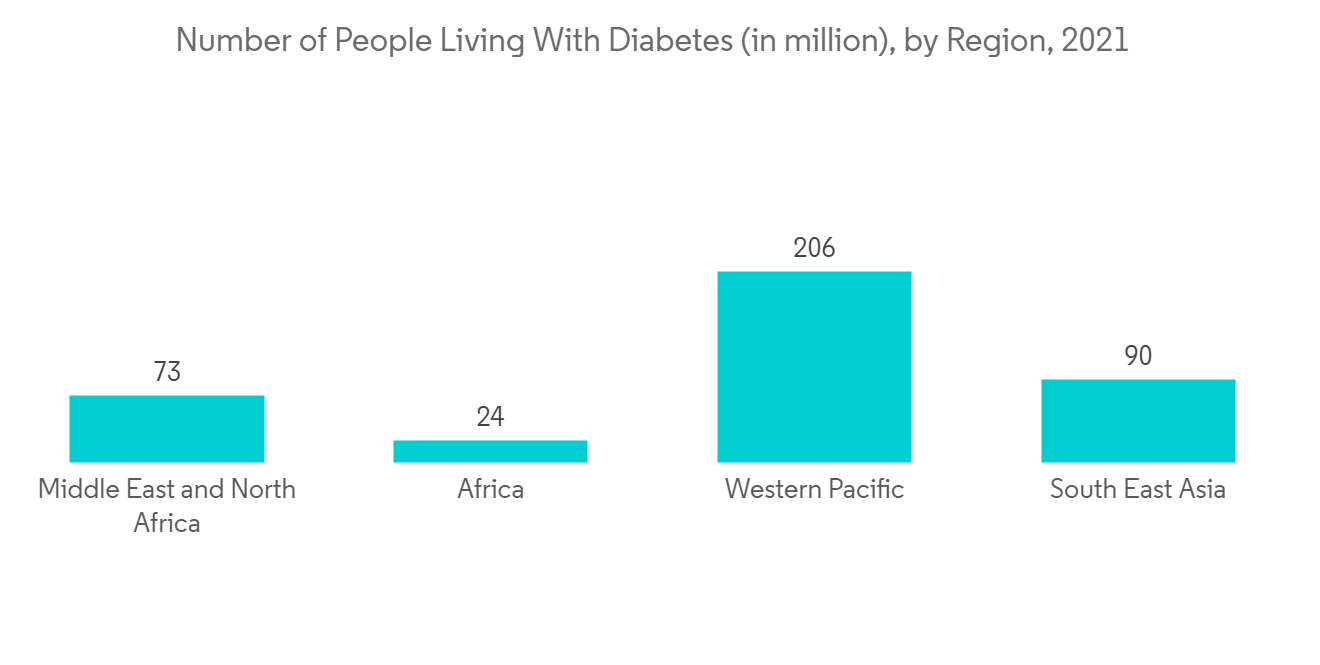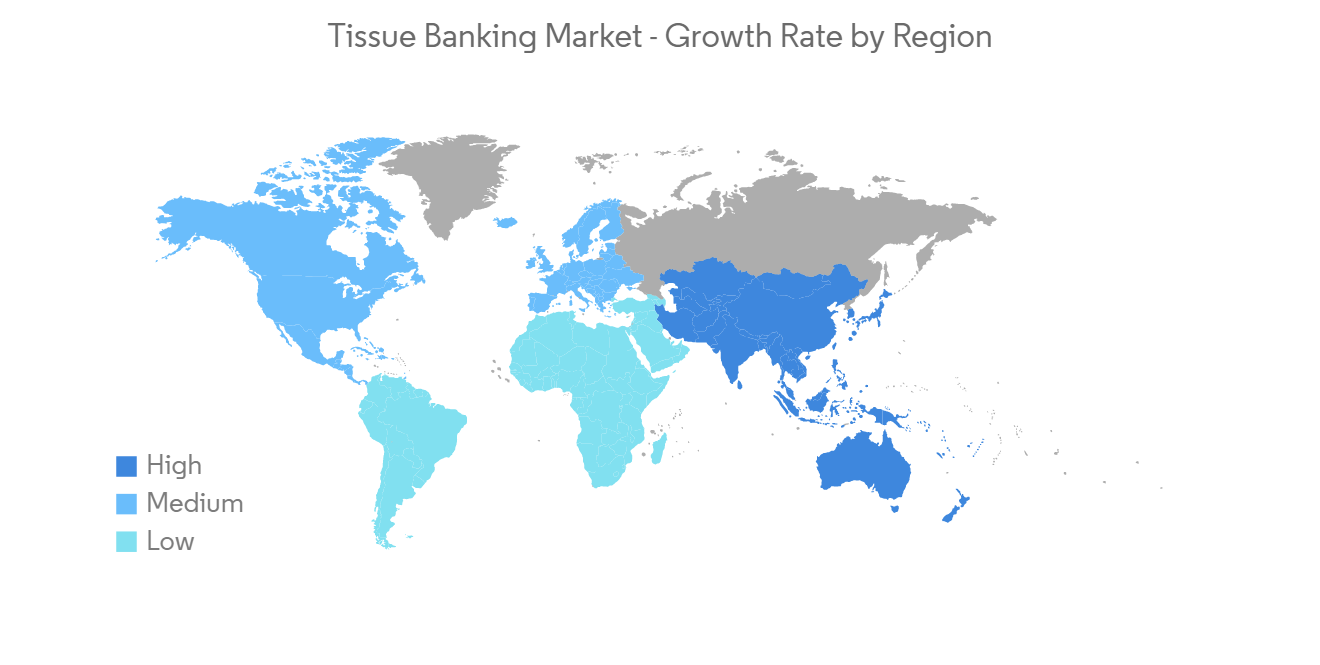 |
市场调查报告书
商品编码
1273494
组织银行市场——COVID-19 的增长、趋势、影响和预测 (2023-2028)Tissue Banking Market - Growth, Trends, and Forecasts (2023 - 2028) |
||||||
※ 本网页内容可能与最新版本有所差异。详细情况请与我们联繫。
在预测期内,组织库市场预计将以 5.9% 的复合年增长率增长。
COVID-19 的突然出现对所研究的市场产生了重大影响。 根据各种研究,在 COVID-19 大流行早期减少外科手术导致组织分布显着减少。 此外,在早期,世界各国报告组织捐献者的数量普遍下降。 由于选择性手术的停止,组织变得稀缺,可用组织被保留用于紧急手术干预和医疗程序。 这些都对研究市场产生了负面影响。
然而,随之而来的大流行激发了干细胞研究,以寻找一种有效的抗 COVID-19 感染疫苗。 例如,根据 2022 年 1 月发表在《干细胞研究与治疗》杂誌上的一篇研究文章,细胞疗法在多种疾病中都有重要的应用,包括肺部、心血管、肝臟、肾臟等疾病,它是一种治愈方法。 因此,他们有望找到治愈 COVID-19 的方法。 此外,如上述来源所述,干细胞疗法和干细胞衍生的类器官模型作为 COVID-19 的新治疗和研究方法受到了广泛关注。 因此,此类实例表明,大流行对市场的增长产生了相当大的影响,预计在预测期内这种情况将持续下去。
不断上升的医疗保健成本、不断增加的慢性病负担以及药物发现和开发方面的技术进步是组织库市场的主要驱动力。 例如,根据世卫组织 2022 年 9 月的更新,慢性病仍然是一项巨大的全球挑战,占 2021 年全球所有死亡人数的 74% 左右。 此外,根据 IDF 2021 年 9 月的更新,到 2021 年将有约 5.37 亿成年人(20-79 岁)患有糖尿病,到 2030 年将有约 6.43 亿人。预计到 2045 年将有约 7.83 亿人患有糖尿病.
此外,根据全球癌症观察站于 2021 年 3 月更新的数据,2020 年约有 1930 万男性和女性新诊断出患有癌症。 报告称,全球癌症发病率正在迅速上升,并估计到 2040 年,男性和女性将有大约 3020 万新发癌症病例。 这样,随着慢性病的增加,组织库的需求预计会增加,因为组织通常用于疾病研究活动、疾病的诊断和治疗。 因此,预计这些因素将在预测期内推动组织银行市场的增长。
但是,预计严格的监管情景将阻碍预测期内的市场增长。
组织库市场趋势
预计医学研究部门在预测期内将增长
通常开展基于组织的医学研究是为了扩展我们对人类生物学的了解,并帮助开发疾病诊断技术、未来治疗方法和治疗方案。 基于组织的研究还有助于快速开发更有效和更安全的药物,并更好地了解影响人类的疾病的潜在过程。 人体组织是医学研究最有效的组织。 它通常是从捐献者死后的手术残渣、血液或其他体液中获得的。 因此,预计医学研究领域的增长将推动分析期间的增长。
在医学研究中,组织利用率的提高和组织覆盖范围的扩大是该领域增长的主要驱动力之一。 例如,根据责任医学医师委员会 2022 年 5 月发表的一篇文章,在科学研究中使用人体组织正在导致疾病进展、药物开发和医疗程序方面的发现,从而改善医疗保健。 器官芯片、3D 生物打印和其他使用人体组织而不是动物的方法提供的结果更能反映人类健康。
上述消息来源表明,人体组织目前用于研究癌症、心脏病、糖尿病、阿尔茨海默病和其他痴呆症等病症和疾病,以及治疗帕金森病和多发性硬化症等病症。据报导,用于生物医学研究的许多领域。 人体组织也用于毒理学测试的微流体系统和检测生物或化学危害的生物传感器。 因此,随着医学研究变得更加活跃,对组织库的需求也在增加。 预计这将进一步推动该细分市场的增长。

预计北美将占据很大的市场份额
在预测期内,预计北美将主导整个组织库市场。 这种增长是由于研究活动的增加、慢性病的增加以及北美地区製药公司的增加等因素造成的。
由于组织库筛选捐赠者、检索、处理、储存和/或分发同种异体移植组织,慢性病中心脏病的患病率不断增加,这增加了美国对组织库的需求。正在生产。 根据疾病预防控制中心 2022 年 7 月的更新,心脏病在美国人口中很常见,2020 年冠心病影响了大约 2010 万 20 岁及以上的成年人,是最常见的一种心脏病。
此外,根据加拿大政府2021年8月发布的一份报告,2020年将有超过300万加拿大人,即8.8%的人口被诊断出患有糖尿病,6.1%的加拿大成年人将被诊断出患有糖尿病未来糖尿病。据说这一年患糖尿病的风险很高。 该报告还报告说,加拿大糖尿病患病率的上升以及 COVID-19 对糖尿病患者的负面影响强调了继续投资于糖尿病研究、治疗和预防的重要性。。 因此,这种情况有望推动北美市场的增长。
主要产品的发布、市场参与者和製造商的高度集中、主要参与者之间的收购和合作伙伴关係是推动该国组织库市场增长的一些因素。 此外,政府机构正在大力投资各种组织库项目,这进一步推动了市场的增长。
例如,2021 年 10 月,美国国家人类基因组研究所计划在五年内拨款 3850 万美元用于发育基因型-组织表达 (dGTEx) 项目,以扩大现有基因表达资源,将发育组织纳入其中。 这个项目旨在创建一个广泛可用的组织库和数据库,其中包含许多儿科组织类型中人类发育基因表达的信息,用于美国的基础和临床研究。我正在做。 预计此类投资将有助于该地区的整体市场增长。 因此,由于投资增加和各种疾病的流行,预计北美市场将扩大。

组织银行行业概览
组织库市场竞争激烈,由各种全球和区域市场参与者组成。 竞争格局包括 AMS Biotechnology (Europe) Limited、Avantor, Inc (VWR International)、BioCision LLC、Brooks Automation、Custom Biogenic Systems、Eppendorf AG、Hamilton Company、Merck KGaA、Thermo Fisher Scientific, Inc。简介国际和本地公司。
其他福利:
- Excel 格式的市场预测 (ME) 表
- 3 个月的分析师支持
内容
第一章介绍
- 研究假设和市场定义
- 本次调查的范围
第二章研究方法论
第 3 章执行摘要
第四章市场动态
- 市场概览
- 市场驱动因素
- 医疗支出增加
- 慢性病负担加重
- 药物发现和开发方面的技术进步
- 市场製约因素
- 严格的监管场景
- 波特五力
- 新进入者的威胁
- 买方/消费者议价能力
- 供应商的议价能力
- 替代品的威胁
- 竞争公司之间的敌对关係
第 5 章市场细分
- 按产品分类
- 设备
- 低温保存装置
- 除霜装置
- 质量控制设备
- 其他
- 媒体和消耗品
- 设备
- 通过使用
- 治疗药物
- 用于医学研究
- 其他用途
- 按地区
- 北美
- 美国
- 加拿大
- 墨西哥
- 欧洲
- 德国
- 英国
- 法国
- 意大利
- 西班牙
- 其他欧洲
- 亚太地区
- 中国
- 日本
- 印度
- 澳大利亚
- 韩国
- 其他亚太地区
- 中东和非洲
- 海湾合作委员会
- 南非
- 其他中东和非洲地区
- 南美洲
- 巴西
- 阿根廷
- 其他南美洲
- 北美
第六章竞争格局
- 公司简介
- Rokit Healthcare Inc.
- AMS Biotechnology(Europe)Limited
- Avantor, Inc(VWR International)
- Sartorius AG
- Azenta Life Sciences
- Bio-Rad Laboratories Inc.
- Eppendorf AG
- Hamilton Company
- Merck KGaA
- Thermo Fisher Scientific, Inc.
- LifeLink Tissue Bank
- BioLife Solutions
第七章市场机会与未来趋势
The tissue banking market is expected to register a CAGR of 5.9% over the forecast period.
The sudden emergence of COVID-19 had a significant impact on the market studied. According to various research studies, tissue distribution has been greatly reduced because of the decrease in surgical activity in the initial days of the COVID-19 pandemic. It was also reported that during the very initial period, a general drop in the number of tissue donors had been observed in various countries globally. Due to the cancellation of elective operations, there was a scarcity of tissues, and the available tissues were only utilized in urgent surgical interventions or medical procedures. These impacted the studied market adversely.
However, during the later pandemic, the trend for stem cell research increased to find effective vaccines for COVID-19 infection. For instance, according to a research article published in the Stem Cell Research and Therapy journal in January 2022, cell therapy is a significant treatment applied in several diseases, including lung, cardiovascular, liver, kidney, and other diseases. Thus these are anticipated to find a cure for COVID-19. Also, as per the source above, stem cell therapy and stem cell-derived organoid models received huge attention as a new treatment and research method for COVID-19. Therefore, such instances indicate that the pandemic had a considerable impact on the market growth, and it is expected to continue its growth over the forecast period.
The rising healthcare expenditure, the growing burden of chronic diseases, and technological advances in drug discovery and development are the major drivers for the tissue banking market. For instance, according to September 2022 update by WHO, chronic diseases have always been a massive global challenge, and they accounted for approximately 74% of all deaths worldwide in 2021. Furthermore, according to the September 2021 update by IDF, around 537.0 million adults (20-79 years) were living with diabetes in 2021, and around 643 million and 783 million people are expected to live with diabetes by 2030 and 2045, respectively.
In addition, as per the Global Cancer Observatory data updated in March 2021, nearly 19.3 million new cases of cancer were diagnosed in 2020 globally among both men and women. The same source reported that the incidence of cancer was growing at a rapid pace in the world and estimated that the number of new cases of cancer in both sexes is projected to reach around 30.2 million by 2040. Thus, with the increasing number of chronic diseases, the demand for tissue banks is anticipated to increase as tissues are generally used in research activities related to diseases and the diagnosis and treatment of diseases. Therefore, such factors are anticipated to propel the tissue banking market growth over the forecast period.
However, a stringent regulatory scenario is expected to hinder market growth over the forecast period.
Tissue Banking Market Trends
Medical Research Segment is Expected to Witness Growth Over the Forecast Period
Medical research using tissues generally helps to expand knowledge regarding human biology and helps to develop disease diagnosis techniques, future therapies, and treatment protocols. In addition, conducting research using tissues enables the faster development of more effective, safer drugs and a better understanding of the underlying disease processes that affect humans. Human tissues are the most effective tissues for medical research. They are typically obtained from post-mortem of people who are organ donors, as leftovers from surgery, and through blood or other body fluids. Thus, owing to the increase in the medical research segment, growth is expected over the analysis period.
The increasing use of tissues and the wide applicability of tissues in medical research is one of the key drivers for segment growth. For instance, according to an article published by the Physicians Committee for Responsible Medicine in May 2022, the use of human tissues in scientific research has improved health care by leading to discoveries in disease progression, drug development, and medical procedures. Organs on chips, 3D bioprinting, and other methods that use human tissue instead of animals provide results that translate better to human health.
The source above also reported that human tissues are currently used in many areas of biomedical research, including research on conditions and diseases such as cancer, heart disease, diabetes, Alzheimer's disease, and other dementias, and for the treatment of conditions such as Parkinson's disease and multiple sclerosis. Human tissue is also used in microfluidic systems for toxicology testing and as biosensors for detecting biological or chemical hazards. Thus, owing to the upsurge in medical research, the demand for tissue banking is increasing. This is further expected to fuel the segment's growth.

North America is Expected to Hold a Significant Share of the Market
North America is expected to dominate the overall tissue banking market over the forecast period. The growth is due to factors such as increasing research activities, a rise in chronic diseases, and an increasing number of pharmaceutical companies in the North American region.
As tissue banks provide donor screening, recovery, processing, storage, and/or distribution of allograft tissue, the increasing prevalence of heart diseases among chronic diseases is creating demand for tissue banks in the United States. According to the July 2022 update by CDC, heart disease is common among the population of the United States, and coronary heart disease was the most common type of heart disease which affected nearly 20.1 million adults aged 20 or above in 2020.
In addition, according to the report published by the Government of Canada in August 2021, more than 3.0 million Canadians, or 8.8% of the population were diagnosed with diabetes in 2020, and 6.1% of Canadian adults are at high risk of developing diabetes in the upcoming years. It also reported that the increasing prevalence of diabetes in Canada and the negative impacts of COVID-19 on people with diabetes have underscored the importance of continued investment in diabetes research, treatment, and prevention. Therefore, such a scenario is expected to propel market growth in North America.
Key product launches, high concentration of market players or manufacturers, acquisitions, and partnerships among major players are among the factors driving the growth of the tissue banking market in the country. Additionally, government organizations are heavily investing in various tissue-banking projects, which is further fueling the market growth.
For instance, in October 2021, the National Human Genome Research Institute planned to expand existing gene expression resources to include developmental tissues by awarding USD 38.5 million over five years to the Developmental Genotype-Tissue Expression (dGTEx) project. This project aims to build a widely available tissue bank and database with information about human developmental gene expression in many types of tissues from children for use in basic and clinical research in the United States. Such investments are expected to contribute to the overall, market growth in the region. Therefore, owing to increasing investments and the prevalence of various diseases, the studied market is anticipated to witness growth in North America.

Tissue Banking Industry Overview
The tissue banking market is competitive in nature and consists of various global and regional market players. The competitive landscape includes an analysis of a few international as well as local companies which hold the market shares and are well known, including AMS Biotechnology (Europe) Limited, Avantor, Inc (VWR International), BioCision LLC, Brooks Automation, Custom Biogenic Systems, Eppendorf AG, Hamilton Company, Merck KGaA, and Thermo Fisher Scientific, Inc. among others.
Additional Benefits:
- The market estimate (ME) sheet in Excel format
- 3 months of analyst support
TABLE OF CONTENTS
1 INTRODUCTION
- 1.1 Study Assumptions and Market Defination
- 1.2 Scope of the Study
2 RESEARCH METHODOLOGY
3 EXECUTIVE SUMMARY
4 MARKET DYNAMICS
- 4.1 Market Overview
- 4.2 Market Drivers
- 4.2.1 Rising Healthcare Expenditure
- 4.2.2 Growing Burden of Chronic Diseases
- 4.2.3 Technological Advances in Drug Discovery and Development
- 4.3 Market Restraints
- 4.3.1 Stringent Regulatory Scenario
- 4.4 Porter Five Forces
- 4.4.1 Threat of New Entrants
- 4.4.2 Bargaining Power of Buyers/Consumers
- 4.4.3 Bargaining Power of Suppliers
- 4.4.4 Threat of Substitute Products
- 4.4.5 Intensity of Competitive Rivalry
5 MARKET SEGMENTATION (Market Size by Value - USD Million)
- 5.1 By Product
- 5.1.1 Equipment
- 5.1.1.1 Cryopreservation Equipment
- 5.1.1.2 Thawing Equipment
- 5.1.1.3 Quality Control Equipment
- 5.1.1.4 Others
- 5.1.2 Media and Consumables
- 5.1.1 Equipment
- 5.2 By Application
- 5.2.1 Therapeutics
- 5.2.2 Medical Research
- 5.2.3 Other Applications
- 5.3 Geography
- 5.3.1 North America
- 5.3.1.1 United States
- 5.3.1.2 Canada
- 5.3.1.3 Mexico
- 5.3.2 Europe
- 5.3.2.1 Germany
- 5.3.2.2 United Kingdom
- 5.3.2.3 France
- 5.3.2.4 Italy
- 5.3.2.5 Spain
- 5.3.2.6 Rest of Europe
- 5.3.3 Asia-Pacific
- 5.3.3.1 China
- 5.3.3.2 Japan
- 5.3.3.3 India
- 5.3.3.4 Australia
- 5.3.3.5 South Korea
- 5.3.3.6 Rest of Asia-Pacific
- 5.3.4 Middle East and Africa
- 5.3.4.1 GCC
- 5.3.4.2 South Africa
- 5.3.4.3 Rest of Middle East and Africa
- 5.3.5 South America
- 5.3.5.1 Brazil
- 5.3.5.2 Argentina
- 5.3.5.3 Rest of South America
- 5.3.1 North America
6 COMPETITIVE LANDSCAPE
- 6.1 Company Profiles
- 6.1.1 Rokit Healthcare Inc.
- 6.1.2 AMS Biotechnology (Europe) Limited
- 6.1.3 Avantor, Inc (VWR International)
- 6.1.4 Sartorius AG
- 6.1.5 Azenta Life Sciences
- 6.1.6 Bio-Rad Laboratories Inc.
- 6.1.7 Eppendorf AG
- 6.1.8 Hamilton Company
- 6.1.9 Merck KGaA
- 6.1.10 Thermo Fisher Scientific, Inc.
- 6.1.11 LifeLink Tissue Bank
- 6.1.12 BioLife Solutions










